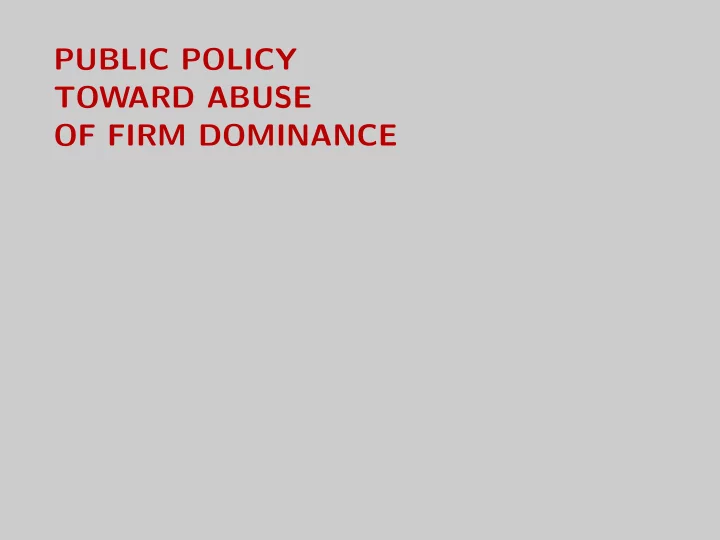

PUBLIC POLICY TOWARD ABUSE OF FIRM DOMINANCE
Outline • Public policy: false positives and false negatives • Cases
Outline • Public policy: false positives and false negatives • Cases
Basic trade-off: Type I and Type II errors • Errors in decision making can be classified as − False positive: competitive practice labeled anti-competitive − False negative: anti-competitive practice labeled competitive • Trade-off increasingly difficult as we move down the list: − Horizontal agreements − Mergers − Dominant position (e.g., exclusion)
Observable conditions and economic effects Horizontal agreements • Price fixing Common standard • Anti-competitive Pro-competitive
Observable conditions and economic effects Aggressive pricing • Below cost pricing Quantity discounts • Anti-competitive Pro-competitive
Exercise: pro-competitive or anticompetitive? • Below cost pricing • Bundling, quantity forcing, etc • Exclusive contracts • Pay for delay
Beware of false positives (dominant firm) • Competitive justification frequently correct • Preemptive effect on firm’s competitive strategies • The extreme statistics phenomenon − Multiple jurisdictions with global impact − Jurisdiction balance expected costs from false positives, negatives − Binding decision is toughest − In expected terms, it will likely be a false positive
US and EU on predatory pricing U.S. E.U. Market Necessary condition Necessary condition dominance Price test p < AVC p < AAC per se illegal necessary condition p > LRAIC OK (?) Recoupment Reasonable prospect Not necessary Intent Talk is cheap Helpful in proof Key quote Predatory pricing schemes A dominant undertaking are rarely tried, and even has no interest in applying more rarely successful such prices except that of eliminating competitors AVC: Average Variable Cost. AAC: Average Avoidable Cost. LRAIC: Long Run Average Incremental Cost. Quotes from Justice L. Powell on Matsushita , 1986; and European Court of Justice on AKZO .
Competition policy and football The competition authority must be like a good referee: easy enough to let the game flow but not too easy to the point of letting the game become a mess.
Outline • Public policy: false positives and false negatives • Cases
Microsoft • What is the idea of the “fee for processor” strategy? • What was the thrust of the DOJ 1998 case against Microsoft? • What arguments would you present against and in favor of Microsoft? • Would you answer be different in 2004 than 2014?
AMD vs Intel • Intel offers rebates to customers (PC manufacturers) who agree to limit purchases from AMD • Compaq’s CEO Michael Capellas tells AMD (in 2000) “I had a gun to my head” and had to stop buying AMD chips • AMD engages in a global litigation strategy − files complaint with competition authorities in EU, Korea, Japan − files lawsuit in US for discovery of certain Intel docs − files lawsuit in US re Intel’s practices (2004) • Various government initiated cases: Japan; Korea; EU DG Comp (2004); and NY AG (2009)
AMD vs Intel • US Supreme Court approves legal strategy of suing abroad and pursuing discovery at home • Japan and Korea competition authorities fine Intel in the $ millions • Intel and AMD settle US dispute in 2009: − Intel to pay AMD $1.25 billion and abide by a long list of prohibitions; − AMD to drop its litigation efforts worldwide (suits and complaints) • DG Comp fines Intel e 1.06 ($1.44 billion at the time) EU court to rule June 12 on Intel appeal
AMD vs Intel: takeaways • Global antitrust − Suing in parallel fronts across the world − Choosing more favorable jurisdiciton − Spillovers across cases • No “double jeopardy” protection • Rule of reason implies legal uncertainty It’s as easy to find legal certainty in this case as it is for scientists to discover the Higgs boson — Intel lawyer Nicholas Green
Solvay and Actavis • Solvay receives 2003 patent for brand-name drug, Androgel (low testosterone levels). • Actavis files 2003 patent for generic modeled after Androgel. • Solvay sues Actavis for patent infringement under “paragraph IV” litigation (Hatch-Waxman Act) • Actavis enters a reverse payment settlement agreement with Solvay (2006), whereby Actavis − keeps its generic drug off the market (for a “specified number of years”) − agrees “to promote Androgel to doctors” − receives monetary compensation
Solvay and Actavis • In 2013, US Supreme Court rules 5-3 that FTC cannot be prevented from bringing antitrust action against defendants • Stopped short of declaring pay-for-delay illegal • Previously Supreme Court had refused to hear similar cases and FTC had lost
Solvay and Actavis: takeways • Relation (and possibly conflict) between patent law and antitrust law
Spirit Airlines vs Northwest Airlines • What are the case facts regarding pricing? • What are the points of factual disagreement? • What are the legal standards for predation? • How would you have advised Spirit Airlines?
Spirit Airlines $ Detroit-Boston 300 250 200 150 100 Northwest Airlines Spirit Airlines 50 0 Jan 1995 Jan 1996 Jan 1997 Jan 1998
Spirit Airlines: takeaways • In theory, we agree; in practice we don’t • US standards to prove predation are very high
Recommend
More recommend